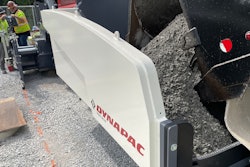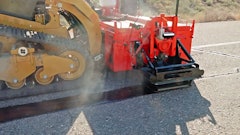
Closure was not an option for an airport with only a single runway and commercial airlines to serve. That was S.T. Wooten’s challenge when the team began a rehabilitation project at the Albert J. Ellis Airport (OAJ) in Richlands, North Carolina. Offering daily flights to and from Charlotte and Atlanta, many of the airport’s passengers are busy military service members and families travelling back and forth from the nearby Marine Corps Base Camp Lejeune.
With the runway’s surface in poor condition, OAJ decided it was time to move forward with a contract to replace the runway surface, markings and lighting. Crews had to work around daily air traffic schedules with Delta and American Airlines flights. The ability to plan and execute through a tight window of only six and a half hours of nightly runway closure helped turn the challenge into a successful project.
A Custom-Built Itinerary
When it came to planning for the OAJ job, accommodating airline schedules was a top priority. “When you only have one runway, it HAS to be open,” said Project Manager Jennifer Kiglics. “Therefore, we had to establish a comprehensive team of crews, subcontractors, and have multiple contingency plans in place to avoid interference with those schedules.”
Construction involved milling and resurfacing of the runway stretching 7,100 feet, including six taxiway connectors. Close collaboration helped to establish realistic expectations so the work be achieved on the tight, four-month project timeline.
Guidelines were still a challenge for crews. The team had to:
- Perform all work at night since the runway was in use during the day.
- Wait to start work until all flight arrivals were clear – a moving target since flight schedules are often delayed.
- Juggle airline schedules, weather, subcontractors and lots of moving parts in the overall project plan.
- Leave the runway “finished, inspected, and usable” each morning for the first departure.
- Reopen the runway each morning by 5:30 a.m. or face a $100 per minute fine.
Being fully “open and operational” also meant that not only did the pavement have to be complete, but it also had to be marked by a subcontractor – every single morning.
Ready for Takeoff
Along with work schedules, Wooten faced challenges in having the contract start date delayed, as the airport needed extra time to negotiate closure schedules with the airlines. It took time to clear bookings and adjust schedules that worked for both flights and construction teams. The six and half hour closure window was only guaranteed for two months.
General Superintendent George Meeks noted that while challenging, “we were all ready to go each night. Everyone pulled their own weight and just got it done.”
Crews worked attentively to adjust as conditions changed once the project took off. Each night, Meeks and his team would monitor the last flight’s arrival time – which was usually around 10 or 11 p.m. Crews would then calculate how much mill and fill work could be done, and how much time was needed to clean up and get everything off the runway before 5:30 a.m.
No night was ever the same.
“Some of the flights would be an hour or even 90 minutes behind schedule,” Kiglics said, “and you’d just lose that production time.”
While changing conditions often meant a morning rush to reopen, crews never reopened late and never had to pay any liquidated damages.
Getting It Done
After the first week of construction on OAJ, a productive system was developed between all the divisions involved in the project to help keep things running smoothly. Contingency plans were also put in place with redundant equipment on-site in cases of equipment malfunction or failure.
As always, the weather was a factor in getting the project completed on time. “The specifications stated that work should not proceed if 30 minutes prior to the scheduled start, the National Weather Service forecast included more than a 50% chance of precipitation,” explained Kiglics. “And we had crews coming in from hours away.”
“Once we started to make progress, the owners saw that our system was working,” she continued. “So, they relaxed a little and let us work.”
A Team Effort
While OAJ was a high-pressure project, teamwork helped crews keep things moving forward and ultimately completed by the October deadline. A big thanks must be given to both our production and quality control teams.
Turbulence is always a possibility on a fast-paced, multi-faceted project like OAJ. Collaboration and experience helped weather the storm and make for a smooth landing.











![Lee Boy Facility 2025 17 Use[16]](https://img.forconstructionpros.com/mindful/acbm/workspaces/default/uploads/2025/09/leeboy-facility-2025-17-use16.AbONDzEzbV.jpg?ar=16%3A9&auto=format%2Ccompress&fit=crop&h=135&q=70&w=240)








